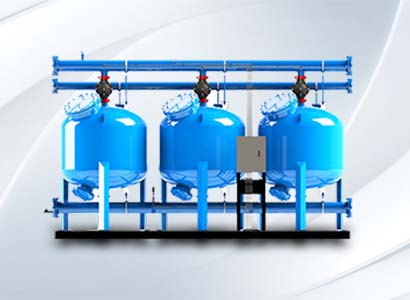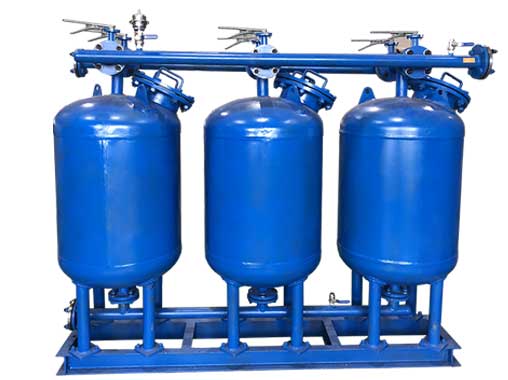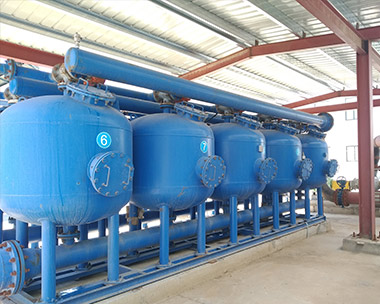introduction:
The pursuit of clean, potable water remains a paramount challenge for humanity. One sophisticated tool that has emerged to answer this challenge is the Shallow Sand Filter. The Shallow Sand Filter is a multifaceted device that offers a great deal in terms of water treatment and purification across several industries.

Functionality and Design:
Shallow Sand Filter operates based on a well-structured system of unique internal water distribution and water collectors, augmented by a unique automatic flushing valve. This system comprises numerous high-speed standard sand cylinder units, which, during normal system operation, are individually back-washed. The movement of water through these cylinders facilitates filtration, while the automatic flushing results in the seamless removal of trapped particles. Significantly, the filter continues its operation even during backwashing, thus providing a near-constant water treatment service.
Key Features:
Stemming from its design and operational principles, Shallow Sand Filters boast of high filtration speed, low pressure loss, and the ability to completely address issues plaguing common mechanical media filters like slow filtration speed and small flow rate. They allow for manual, semi-automatic and automatic backwashing, satisfying a vast array of user needs. The architecture of the Shallow Sand Filter units also helps minimize spatial footprint, hence saving costs and reducing complexities in deployment.
Efficiency and Adaptability:
Aside from its high-functionality, the Shallow Sand Filter is also highly adaptable. The filter can operate as a stand-alone filtration system or function in conjunction with existing process supply pumps. This flexibility could even be witnessed in its configuration options, as it comes in both vertical and horizontal series to cater to various water-quality treatment needs across many fields.
Relevance in Various Industries:
In the wider industrial context, Shallow Sand Filters are pivotal in sectors like aquaculture, swimming and water parks, irrigation, and industrial water treatment. They offer superior filtration for water suspensions, particulates, dirt, algae, rust, etc., thereby enhancing the overall quality of water.
In the world of medical and raw water treatment, their high-efficiency filtration capability makes them a preferred choice when sterilization and purity are indispensable. For industrial process water filtration, their continuous operation and large throughput mean that they can handle high volumes of water without interruptions.
Shallow Sand Filter and Sustainability:
A key aspect of Shallow Sand Filters is that they are environmentally sustainable. The filters require less water for backwashing, and the backwash effluent can be discharged safely without causing harm to the environment.
Conclusion:
Shallow Sand Filters represent an uncompromised combination of performance, convenience, and responsibility towards the environment. With such advanced filtration technology, we are poised for a future where access to clean water becomes increasingly prevalent.
With continuous improvements and customization, Shallow Sand Filters are bound to become even more crucial in the journey towards global water sanitation and safety. Already, we see their impact in various areas of human endeavor – from environmental protection to the provision of lifesaving medical services. Shallow Sand Filters are not just filtering water – they are paving the way for a healthier and safer world.
The automatic flushing valve in the Shallow Sand Filter plays a crucial role in the system's maintenance and efficacy. Its purpose is to facilitate the regular cleaning of the filter by removing the accumulated particles, ensuring optimal performance, and prolonging the lifespan of the filter.

Here's a step-by-step breakdown of how it works:
Sensing pressure differential: As water passes through the filter, impurities and particulates get trapped, gradually leading to a buildup. This buildup causes an increase in the pressure difference between the inlet and outlet of the system. The automatic flushing valve has a pressure differential switch that can detect when this difference exceeds a preset limit.
Triggering backwash cycle: The pressure differential switch triggers the backwash cycle once the preset limit is surpassed. This change is signalled to the control system of the filter.
Reverse flow: In response to the signal, the automatic flushing valve activates and reverses the water flow. It redirects some of the filtered water from the outlet back to the inlet of the system.
Backwashing: The redirected water flows in the reverse direction (from the bottom to the top of the filter) carrying the trapped particles along with it. This water, now carrying the accumulated particles, is directed out of the system through the flushing valve.
End of backwash cycle: The backwash cycle lasts for a few minutes and is terminated once the pressure differential reduces to the pre-set level. The automatic flushing valve then returns to its original position, and the filter resumes its normal operation.
Manual/Time-based intervention: Additionally, the backwash cycle can also be manually triggered or set to initiate based on a timer - allowing for regular automated maintainence.
This automatic process aids in maintaining the filter's efficiency and effectiveness with minimal manual intervention and ensures consistent operation. Moreover, it does this while the filtration process continues without interruption in the other sand cylinder units of the system.
If the pressure differential switch fails to detect the increased pressure difference, the backwashing cycle may not be triggered automatically, leading to several issues:
Clogging: Over time, more and more particles would get trapped in the filter media (sand) without being cleared out through backwashing. This could eventually lead to clogging, significantly reducing the filtration efficiency and the flow rate of water through the system.
Increased pressure loss: The growing amount of trapped particles within the filter media would also cause pressure loss across the system, requiring more energy to pump the same amount of water through the filter.
Potential damage: The clogging and increased pressure could, in worst-case scenarios, result in system overloads or mechanical damage to the unit.
Lower water quality: The accumulation of particles also implies that newer incoming contaminants may not be effectively filtered out and can pass through the system, compromising the quality of the filtered water.
System inefficiency: The system may use more energy to work harder to maintain the flow rate, leading to energy inefficiency.
To prevent these issues, regular maintenance and inspection of the automatic flushing valve and the pressure differential switch should be performed. This would include checking the pressure differential switch's setting and functionality. If the setting is too high, it may delay or prevent necessary backwashing cycles.
In addition, using redundant or backup systems can help alleviate this issue. The system could be set to initiate a backwash cycle based on a timer, ensuring regular maintenance, even if the pressure differential switch fails to trigger the process automatically.
Also, monitoring systems can alert the operators if the pressure differential gets too high, or if decreased flow rates or filtration efficiency are detected. Implementing these measures would ensure consistent operation and the durability of the Shallow Sand Filter.
The frequency of inspection and maintenance of the pressure differential switch can depend on several factors, including the volume of water processed, the level of contaminants in the water, and the overall system configuration. Nevertheless, as a general rule of thumb, it's recommended to inspect these systems quarterly or at the least, every six months.
That said, the following guidelines should be considered:
Regular Inspections: On a quarterly or semi-annual basis, inspect visually for any signs of physical damage, leaks, or abnormal behavior.
Performance Monitoring: Keep a close eye on the system's performance. Sudden changes in pressure differences, reduced flow rates, or decreased filtration efficiency could potentially indicate a problem with the pressure differential switch.
Preventive Maintenance: While inspections can be made semi-annually, a preventive maintenance procedure should be undertaken annually. This process would entail an in-depth look, cleaning of the valve, ensuring the correct calibration, and potential replacement of worn-out parts.
Extensive Maintenance: Every 2-3 years, a more extensive maintenance service should be conducted. This could involve complete dismantling, inspection, replacement of worn-out parts, recalibration, and reinstallation of the pressure differential switch.
Remember that these are general guidelines and the actual frequency should be determined by the operational conditions and manufacturer's advice. Always document all inspections, maintenance operations, and any corrective actions taken to maintain a detailed service history. This proactive approach will ensure the longevity and efficient functioning of the Shallow Sand Filter system.

Absolutely, preventive maintenance is crucial to ensure the longevity and efficiency of the pressure differential switch. Here's a general overview of the preventive maintenance procedure:
1. Switch Off the System:
Always start by turning off the entire system to ensure safety during the procedure. This keeps anyone working on the system safe from sudden flows or changes in pressure.
2. Physical Inspection:
Visually inspect the differential pressure switch for any external signs of damage such as cracks, leaks, corrosion, or faulty connections. Fix the noticeable damages, if any.
3. Clean the Switch:
Detach the switch and carefully clean it, removing any potential buildup or debris. The exact method to detach will depend on the make and model of the module, refer to the manufacturer's instructions before performing this step.
4. Internal Inspection:
Once dismantled, closely inspect the interior components. Look for signs of wear, damage, or foreign material. If you're qualified, you may also check the switch’s internal wiring and connection for any sign of damage or fraying.
5. Component Replacement:
If any internal parts or seals show signs of wear or damage, replace them. Any delayed replacement of worn-out components can impact the system's efficiency and can develop into more serious problems.
6. Recalibration:
Recalibrate the pressure differential switch as per the manufacturer's instructions. It's crucial to ensure the switch triggers the backwash cycle at the correct differential pressure setting. If this is not set right, it can lead to premature triggering (resulting in wasted water) or delayed triggering (resulting in system clogging).
7. Reinstall the Switch:
Put everything back together and double-check to ensure all components, seals, and fittings are correctly installed and secure.
8. Test Run:
Restart the system and observe the operation of the pressure differential switch. Ensure the system reaches normal operation parameters and that the switch activates appropriately.
9. Keep Records:
Document the maintenance performed, any observations, replacements made, and general state of the system. This record helps identify recurring problems and aids in future troubleshooting.
Remember, this is a generic procedure and may need to be adjusted based on your specific system and manufacturer's instructions. If you are unsure at any step, consult with a professional technician or the system provider. Regular preventive maintenance not only prolongs the lifespan of the instrument but also reduces the risk of unexpected system failures.








